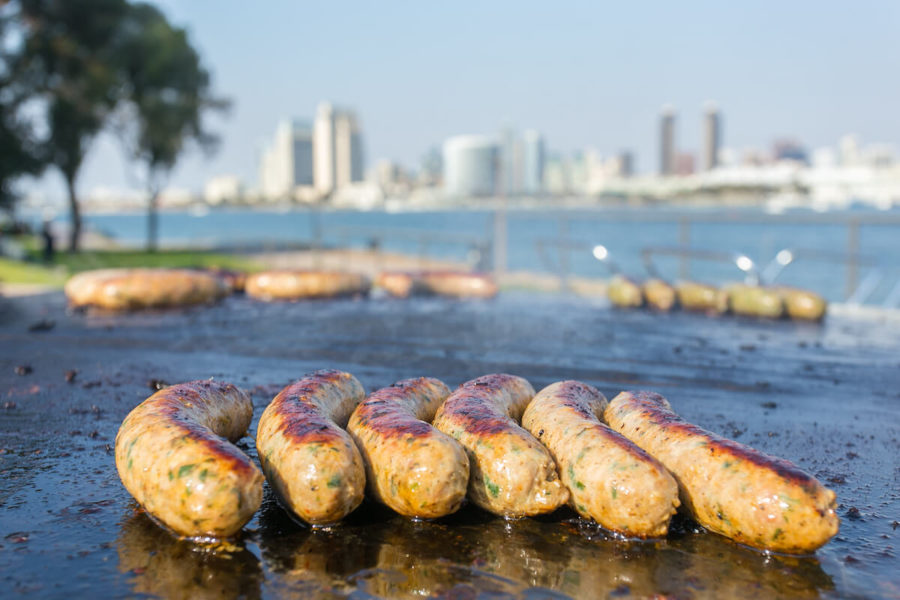Awesome Barbecue Tips from San Diego Pitmasters
There’s nothing like a backyard barbecue with awesome friends + family, food, drink and sunny skies in America’s Finest City to wrap up summer!
We know you, our fellow foodies, are always looking for ways to be the host with the most and put your best plate forward, so we’ve asked some of San Diego’s finest pitmasters to share their best barbecue tips and advice. Fire up the grill and get ready to channel your inner pitmaster!

When it comes to barbecue, it’s always best to use the “slow and low” methodology. I typically try to keep my smoker in between 220 to 230 degrees, ideally maintaining 225 degrees. Every piece of meat will have a different “finishing” temperature, so it’s important to use the right tools which allow you to see temperature.
When smoking pork ribs (St. Louis or Baby Backs), I tend to follow a modification of the 3-2-1 rule. I’ll smoke the meat for 3 hours, then remove. Then I sauce and foil the meat for an additional 2 hours. Finally, I’ll finish the meat on the grill to caramelize the sauce and crisp it up a bit. Not too hot, 300 degrees is a great finishing grill heat. Most importantly: smile wide, laugh loud, live life and eat well!
When setting up your grill, always have a “cooler zone”. This way, if the “hot zone” is too hot, you can simply move the food over to the cooler zone. This prevents serving up meat that is burned on the outside and raw in the center.
Use the lid. Closing the lid on your grill helps you achieve evenly cooked meat, and decreases the cook time.
Have a good “instant read” meat thermometer. Being able to check the meat’s temperature not only helps you cook up perfectly cooked food, but also ensures the food is safe to eat.
Cooking things like chicken over indirect heat eliminates a lot of frustration, bringing the temperature up to where you want, without burning the food over the hot flames. You can do this with steak, and then finish it off (for the sear) over the direct heat.
Keep your grill grates clean. After you have eaten, and the grill is still warm, scrub off the hardened food crumbs and grease from your grill. This will not only make your next cook taste a lot better, but it will increase the lifespan of your grill. Salts from seasoning can cause rust!
This is a tip is for grilling large pieces of chicken. Way back in my Navy days we would have a picnic for the ship’s crew while at sea. Feeding hundreds of hungry sailors can be quite demanding, especially with limited grill space. As everybody knows, there’s nothing worse than biting into a piece of undercooked chicken. So as a solution, we started par cooking the chicken. We would take the raw 8 way cut chicken and slowly cook (low heat) it in a brine (recipe below). We would then cool the chicken down and place it in pans with our BBQ sauce generously poured over it, then grill.
Utilizing the brine solution helps the chicken retain its moisture and adds really great flavor. I recommend cooking the brine for 30 minutes to let the flavors blossom and then cooling down prior to adding the chicken. Place the chicken in the brine for 2 to 3 hours prior to heating, allowing the chicken to absorb the flavors. Make sure to rinse the brine off the outside as it will be really salty if not rinsed.
Whether you’re cooking for 5 or 500 this is a great technique to not only ensure your serving properly cooked food but will make your grilling experience easier so you can enjoy time with the ones you love! On behalf of myself and the TBG BBQ family, we would like to wish everybody a very happy and safe holiday!
Brine Recipe for Poultry:
1 Gallon of Water
2 Cups Kosher Salt
2 Cups Granulated Sugar
5 Sprigs Fresh Rosemary
1 Bunch Fresh Thyme
4 Bulbs Fresh Garlic Peeled
1/3 Cup Black Peppercorns
8 Shallots Cut in Half
When preparing a rub for pork or beef, gently sprinkle it on the meat (instead of rubbing it in). Then let it sit for a minimum of five hours. An easy seasonal rub could be made from toasted fennel seeds, cumin seeds, peppercorns, coriander seeds with salt sugar, smoked paprika, cayenne, garlic powder, and dried oregano.
When attempting to smoke meat or any type of protein it is best to get the fire blazing hot and let it come down until there is no more white smoke. The white smoke is not good for the flavor of the proteins you are cooking. When smoking, prepare a water tray to keep moisture and prevent the meat from drying out. Also, you do not want direct heat. Using a wood like oak or hickory can produce a good flavor. You want the heat to be around 110 degrees Celsius and cook for 7 to 8 hours. When pulling the meat out of the smoker, make sure to wrap it tightly in plastic wrap and let it rest for a minimum of 1 hour.
One of my favorite techniques for barbequing or grilling is to smoke and braise your meats. Place a pan under your meats with any liquid of your choice (I like to use beer) and baste it as it cooks. This keeps your meat really moist and it also adds a beautiful glaze!
Thank you to the awesome chefs who shared their tips and advice with our community.
Happy grilling!







